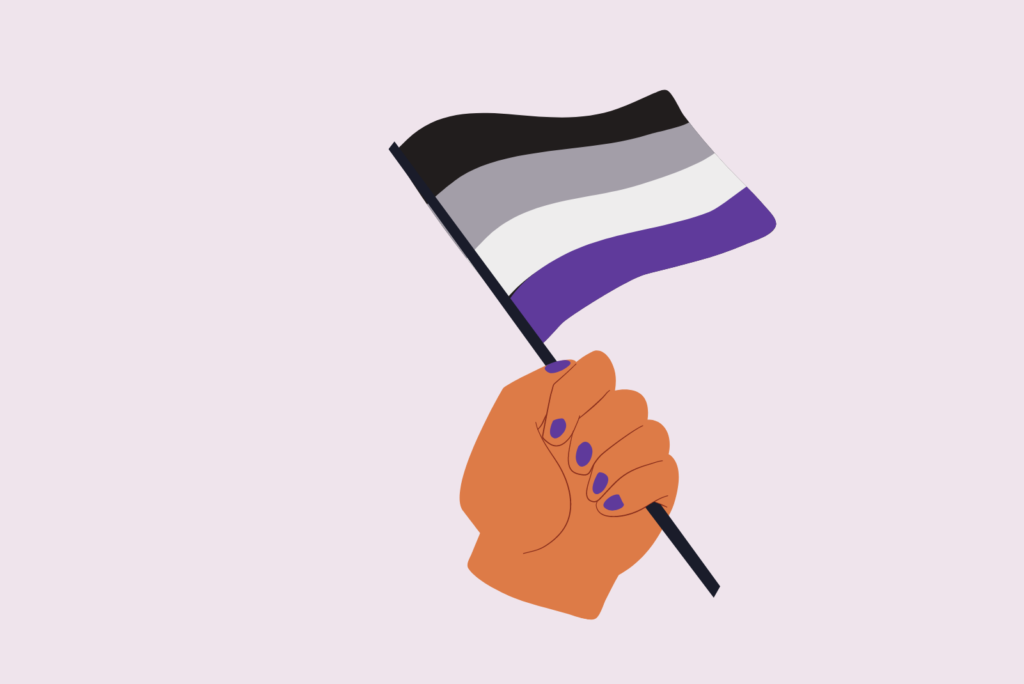In a society often heavily oriented towards sexual attraction, understanding asexuality can be a challenge. This identity, less commonly known but just as valid, often leaves individuals questioning if they ‘fit the mold’. This blog post aims to explore the different asexual signs, delving into the nuances and intersections of this often misunderstood identity. And offering insights to those questioning their sexuality or seeking to understand the experience of asexual individuals in their lives.
Contents
- 1 What Does It Mean To Be Asexual?
- 2 What Are Some Common Asexual Signs?
- 2.1 Lack of Sexual Attraction
- 2.2 Disinterest in Sexual Activity
- 2.3 No Desire for Sex, Even in Relationships
- 2.4 Confusion about Sexual Desire
- 2.5 Sexual Aversion or Indifference
- 2.6 Preference for Other Forms of Intimacy
- 2.7 Rare or Absent Sexual Fantasies
- 2.8 Absence of “Crushes” Involving Sexual Attraction
- 2.9 Lack of Understanding of Sexual Media
- 2.10 Self-realization Over Time
- 3 Do Asexuals Still Fall In Love?
- 4 How To Give Support To Asexual Individuals?
- 5 Conclusion
What Does It Mean To Be Asexual?
 Asexuality refers to a sexual orientation where an individual does not experience sexual attraction to others, irrespective of gender. Unlike celibacy, which is a chosen lifestyle of abstaining from sexual activities, asexuality is an inherent part of one’s identity, not a decision one makes. It’s a spectrum with a range of experiences.
Asexuality refers to a sexual orientation where an individual does not experience sexual attraction to others, irrespective of gender. Unlike celibacy, which is a chosen lifestyle of abstaining from sexual activities, asexuality is an inherent part of one’s identity, not a decision one makes. It’s a spectrum with a range of experiences.
It’s important to note that asexual individuals can still form intimate relationships and experience love. And even engage in sexual activities for various reasons, even though they don’t experience sexual attraction. The experience of being asexual is diverse and unique to every individual, just like any other sexual orientation.
What Are Some Common Asexual Signs?
While the experience of asexuality can differ from person to person, here are some common asexual signs:
Lack of Sexual Attraction
Asexuality is primarily characterized by the absence of sexual attraction towards others. This means that an asexual person may acknowledge someone’s physical beauty or attractiveness, much like appreciating a piece of art, but this recognition does not translate into a desire to have sexual relations with that person. This is distinct from other sexual orientations where physical attractiveness often elicits sexual desire or fantasies.
Disinterest in Sexual Activity
Many asexual individuals express a general disinterest or indifference toward sexual activities. While societal norms often portray sex as an integral part of human interaction, asexual individuals might not share the same perspective. They may not understand the fervor or importance placed on sex. And may prefer to focus on other forms of interaction or expression of love and connection.
No Desire for Sex, Even in Relationships
A common misconception about asexuality is that it’s a phase or situation-dependent. However, even when asexual people are in romantic relationships, they typically do not experience a sexual desire for their partners. Their bonds are primarily founded on emotional, intellectual, or romantic attraction rather than sexual attraction. This is not to say they can’t or won’t engage in sexual activities but their drive to do so isn’t based on personal sexual desire.
Confusion about Sexual Desire
Since our society often assumes that everyone experiences sexual attraction, asexual individuals may grow up feeling confused or alienated by such conversations. They may find it difficult to relate to or understand discussions about sexual desires, cravings, or attractions that their peers seem to experience naturally. This disconnect can often lead to feelings of confusion or being ‘different’ before they understand their asexuality.
Sexual Aversion or Indifference
 While asexuality primarily denotes a lack of sexual attraction, it can also include varying attitudes toward sex. Some asexual individuals may feel aversion or discomfort towards the idea or act of sexual activity, often termed sex-repulsed asexuality. On the other hand, some may be indifferent, viewing sex as a neutral act that neither excites nor repulses them, termed as sex-indifferent asexuality. It’s important to note that these attitudes towards sex are personal and can exist in various combinations within asexual individuals.
While asexuality primarily denotes a lack of sexual attraction, it can also include varying attitudes toward sex. Some asexual individuals may feel aversion or discomfort towards the idea or act of sexual activity, often termed sex-repulsed asexuality. On the other hand, some may be indifferent, viewing sex as a neutral act that neither excites nor repulses them, termed as sex-indifferent asexuality. It’s important to note that these attitudes towards sex are personal and can exist in various combinations within asexual individuals.
Preference for Other Forms of Intimacy
One of the common asexual signs is when individuals often have a pronounced preference for other forms of intimacy as opposed to sexual intimacy. This can include a deep emotional connection, intellectual stimulation, or physical closeness that isn’t inherently sexual like cuddling, holding hands, or hugging. These alternative forms of intimacy provide a source of connection and depth in their relationships that isn’t rooted in sexual desire or activity.
Rare or Absent Sexual Fantasies
Sexual fantasies can be a significant part of many people’s sexual identities, but for asexual individuals, these fantasies tend to be fewer or entirely absent. If an asexual person does have sexual fantasies, they might not involve themselves, or these fantasies might be more abstract and detached from their reality. This is reflective of their lack of sexual attraction towards others.
Absence of “Crushes” Involving Sexual Attraction
When an asexual person has a “crush” or is romantically interested in someone, this interest typically doesn’t involve a desire for sexual activity with that person. Instead, they might be more interested in getting to know the person better, spending more time with them, or deepening their emotional connection. This is because their attraction is generally centered on the person’s attributes or personality rather than their physicality or sexual appeal.
Lack of Understanding of Sexual Media
Asexual individuals might find it challenging to relate to or understand sexual content in various forms of media, including movies, songs, or books. The prominence and centrality of sexual themes in media might seem unnecessary, exaggerated, or even perplexing to them. This can also extend to conversations or social situations where sexual attraction or activity is a primary topic of discussion.
Self-realization Over Time
 For many asexual individuals, understanding their asexuality isn’t an immediate process. It’s often a gradual realization over time, especially considering the lack of awareness and representation of asexuality in society. They may not even be aware that asexuality exists until they encounter the term later in life. Once they learn about it and its meaning, they might feel it accurately describes their feelings and experiences related to sex throughout their lives. Eventually, providing a newfound clarity and understanding of their identity.
For many asexual individuals, understanding their asexuality isn’t an immediate process. It’s often a gradual realization over time, especially considering the lack of awareness and representation of asexuality in society. They may not even be aware that asexuality exists until they encounter the term later in life. Once they learn about it and its meaning, they might feel it accurately describes their feelings and experiences related to sex throughout their lives. Eventually, providing a newfound clarity and understanding of their identity.
Remember, not all asexual individuals will exhibit all these asexual signs. Asexuality, like any other sexual orientation, can vary greatly among individuals. It’s important to respect each person’s self-identification and understand that their experience is unique to them.
Do Asexuals Still Fall In Love?
Yes, asexual individuals can and do fall in love. Asexuality is a sexual orientation that pertains to the lack of sexual attraction to others, not an inability to experience romantic attraction or love. This means that an asexual person can develop deep emotional connections and romantic relationships with others without necessarily feeling sexual desire toward them.
It’s also important to note that romantic orientation can be separate from sexual orientation. Asexual individuals can identify as:
- heteroromantic (romantic attraction to a different gender)
- homoromantic (romantic attraction to the same gender)
- biromantic (romantic attraction to two or more genders)
- panromantic (romantic attraction to people regardless of gender)
- aromantic (no romantic attraction to others), among others
However, everyone is unique, and the way people experience love or attraction can vary widely, even within the asexual community. But it’s essential not to conflate asexuality with aromanticism. While the two can coexist in some individuals, they’re separate and distinct aspects of one’s identity.
How To Give Support To Asexual Individuals?
 Supporting asexual individuals involves understanding, empathy, and respectful actions. Here are a few ways you can offer your support:
Supporting asexual individuals involves understanding, empathy, and respectful actions. Here are a few ways you can offer your support:
- Educate Yourself
Learn about asexuality and the different experiences within the asexual spectrum. Understand the difference between asexuality, aromanticism, and other orientations. Being well-informed can help you engage in supportive conversations and avoid harmful misconceptions.
- Respect Their Identity
Asexual people, like anyone else, have the right to self-identify. Respect their identity, and don’t try to dismiss or invalidate their experiences. Avoid implying that they might ‘change their mind’ later or suggesting that they haven’t met the ‘right person’ yet.
- Be Mindful of Your Language
Use the terms and labels that the person uses to describe themselves. Don’t make assumptions about their experiences or feelings based on your own views of sexuality and attraction.
- Listen and Empathize
If an asexual person chooses to share their experiences with you, listen carefully and empathetically. Avoid unsolicited advice, and offer reassurances that you accept and support them.
- Offer Support in Relationships
If an asexual individual is in a relationship with someone who isn’t asexual, help them navigate the potential challenges. Encourage open and respectful conversations about boundaries, comfort levels, and mutual satisfaction in the relationship.
- Normalize Asexuality
Normalize discussions about asexuality, whether it’s in your social circles, workplaces, or homes. This can help break the stigma and increase understanding about asexuality.
Remember, supporting asexual individuals doesn’t require you to have all the answers. It’s about respecting their experiences, offering empathy, and promoting an accepting environment.
Conclusion
In conclusion, asexual signs can range from a lack of sexual attraction, and disinterest in sexual activities, to the absence of sexual fantasies, among others. It’s crucial to remember that asexual individuals, like everyone else, can experience romantic feelings and fall in love, with their relationships primarily grounded in emotional, intellectual, or romantic attraction.
As allies, our role is to educate ourselves about asexuality, respect asexual identities, and provide a supportive environment free of prejudice and discrimination. Life may sometimes be challenging for asexuals, but Online Asexual Counseling can help. Get experienced LGBTQ therapists at PrideMantra: Book a trial LGBTQ therapy session


